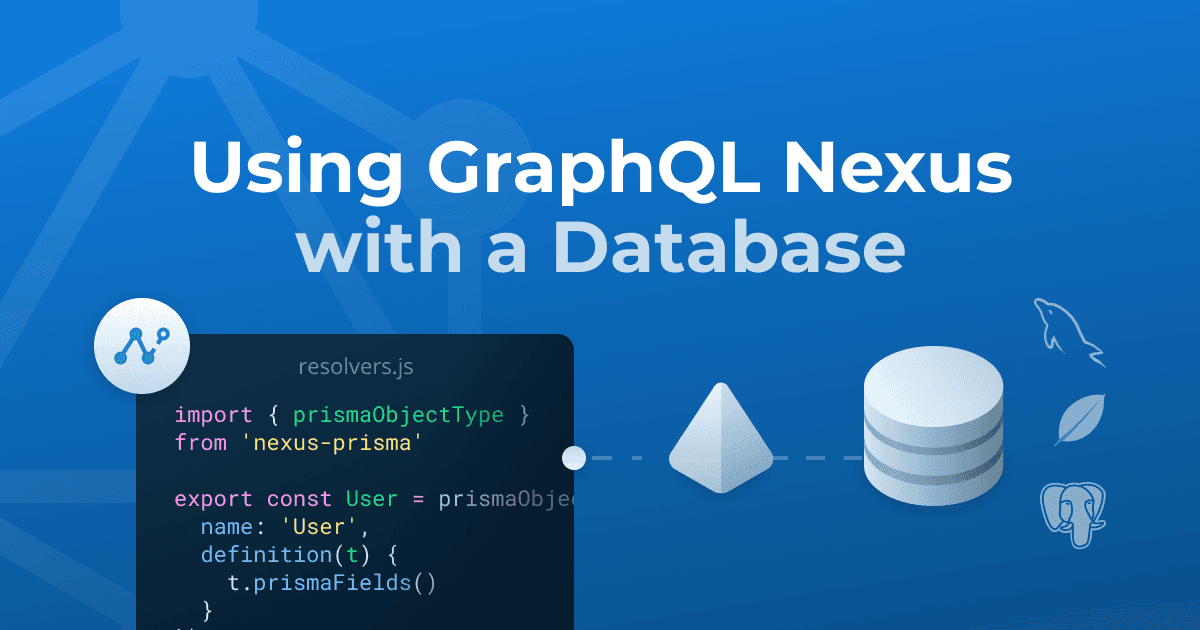GraphQL Nexus 是一个代码优先、类型安全的 JavaScript/TypeScript GraphQL 模式构建库。了解如何使用 Prisma 客户端和新的 nexus-prisma 插件将其连接到数据库。

⚠️ 本文已过时,因为它与 Prisma 1 相关,该版本现已 弃用。要了解有关最新版 Prisma 的更多信息,请阅读文档。⚠️
回顾:使用 GraphQL Nexus 进行代码优先开发
在上一篇文章中,我们介绍了 GraphQL Nexus,这是一个支持 TypeScript 和 JavaScript 代码优先开发的 GraphQL 库。使用 Nexus,GraphQL 模式是sangria-graphql (Scala)、graphlq-ruby 或 graphene (Python)。
今天的文章是关于将基于 Nexus 的 GraphQL 服务器连接到数据库,使用 Prisma 客户端以及新的 nexus-prisma 插件。我们稍后将通过一个从头开始构建博客应用程序的 GraphQL API 的实际示例来指导您。
TLDR:nexus-prisma 插件的优势
- 对 GraphQL 中的 Prisma 模型进行 CRUD 操作
- 自定义您的 Prisma 模型,例如
隐藏某些字段 或添加计算字段 - 完全类型安全:GraphQL 模式和数据库的类型集合一致
- 与 GraphQL 生态系统兼容(例如
apollo-server、graphql-yoga等)
了解 nexus-prisma 工作流
Prisma 客户端作为 ORM 替代方案
如果您之前没有使用过 Prisma,这里快速概述一下它的工作原理
- 定义您的数据模型或让 Prisma 内省您现有的数据库
- 生成您的 Prisma 客户端,即一个类型安全的数据库客户端
- 在应用程序(例如 GraphQL API)中使用 Prisma 客户端访问数据库
nexus-prisma 插件内部原理
当加入 nexus-prisma 时,还有另一个步骤:调用 nexus-prisma-generate 代码生成 CLI。它为您的 Prisma 模型生成完整的 GraphQL CRUD API 的构建块,例如对于 User 模型,它包括
- 查询 (Queries)
user(...): User!:获取单个记录users(...): [User!]!:获取记录列表usersConnection(...): UserConnection!:Relay 连接和聚合
- 变更 (Mutations)
createUser(...): User!:创建新记录updateUser(...): User:更新记录deleteUser(...): User:删除记录updatesManyUsers(...): BatchPayload!:批量更新多条记录deleteManyUsers(...): BatchPayload!:批量删除多条记录
- GraphQL 输入类型
UserCreateInput:封装记录的所有字段UserUpdateInput:封装记录的所有字段UserWhereInput:提供记录所有字段的过滤器UserWhereUniqueInput:提供记录唯一字段的过滤器UserUpdateManyMutationInput:封装可批量更新的字段UserOrderByInput:按字段指定升序或降序
UserCreateInput和UserUpdateInput在处理关系字段的方式上有所不同。
使用 nexus 和 nexus-prisma 编写 GraphQL 服务器代码时,您可以通过公开和自定义这些操作来满足您自己的 API 需求

生成 CRUD 构建块后,您可以使用 nexus-prisma 中的 prismaObjectType 开始公开(和自定义)它们。以下代码片段描述了一个实现,它基于 Prisma 和 nexus-prisma 为 TODO 列表应用程序提供 GraphQL API
我们将 prismaObjectType 应用于 Query 和 Mutation。对于 Query,我们保留所有字段(即 todo、todoes 和 todoesConnection)。对于 Mutation,我们使用 prismaFields 来自定义公开的操作。
prismaFields 允许我们选择要公开的操作。在这种情况下,我们只想保留createTodo)。从生成的 CRUD 构建块中,我们不包含 updateTodo 也不包含 deleteTodo,而是实现我们自己的 markAsDone(id: ID!) 变更,用于标记某个 Todo 已完成。
示例:从标准 CRUD 到自定义 GraphQL API
现在,让我们快速了解一个标准的 Prisma 用例,看看如何通过几个简单的步骤快速为博客应用程序构建 GraphQL API。我们将做以下工作:
- 使用 TypeScript 设置 Prisma 项目(使用免费的演示数据库)
- 定义模型,迁移数据库并生成 Prisma 客户端
- 通过
nexus-prisma公开完整的 CRUD GraphQL API - 通过
nexus-prisma自定义 GraphQL API
如果您想跟着做,需要安装 Prisma CLI
1) 使用 TypeScript、nexus 和 nexus-prisma 设置 Prisma 项目
本节主要介绍您的项目设置。如果您不想跟着编写代码,可以跳过本节,否则请展开下面的部分。
使用 Prisma CLI 创建一个简单的 Prisma 项目
在交互式提示中,选择以下选项
- 选择 演示服务器(包括 Prisma Cloud 中的免费托管演示数据库)
- 在浏览器中使用 Prisma Cloud 进行身份验证(如果需要)
- 回到您的终端,确认所有建议的值
作为演示服务器的替代方案,您也可以使用 Docker 在本地运行 Prisma。
接下来,您需要配置 nexus-prisma 工作流。添加以下依赖项(在 myblog 目录中)
接下来,将以下两行添加到 prisma.yml 的末尾
这确保了无论何时您对模型进行更改,Prisma 客户端以及生成的 nexus-prisma CRUD 构建块都会自动更新。
由于我们使用的是 TypeScript,让我们快速添加一个 tsconfig.json
最后,继续添加一个 start 脚本,您将用它进行开发。它会启动一个开发服务器,在后台监视您的文件并在您编写代码时更新生成的 SDL 和 Nexus 类型定义。将其添加到您的 package.json
2) 定义模型、迁移数据库并生成 Prisma 客户端
prisma init 命令在 datamodel.prisma 中创建了一个默认的 User 模型。由于我们正在构建一个博客应用程序,让我们将模型调整为我们的应用程序域:
接下来,您需要通过将数据模型应用到数据库来迁移数据库。使用以下命令,在 datamodel.prisma 中定义的每个模型都将映射到底层数据库中的一个表:
由于您之前在 prisma.yml 中配置了 post-deploy 钩子,您的 Prisma 客户端和 CRUD 构建块会自动更新。
3) 通过 nexus-prisma 公开完整的 CRUD GraphQL API
在项目的早期阶段,API 公开完整的 CRUD 功能通常很有帮助——更受约束的 API 需求通常会随着时间的推移而出现。nexus-prisma 通过提供从完整 CRUD 到自定义 API 操作的直接路径,完美地考虑了这一点。
让我们从一个 GraphQL API 开始,它为已定义模型公开完整的 CRUD(请注意,这包括过滤器、分页和排序)。创建一个名为 index.ts 的新文件,并向其中添加以下代码:
在这个简短的教程中,我们不太关注文件结构。有关正确的设置和模块化模式,请查看我们的
graphql-auth示例。
运行 npm run start 后,您可以在 https://:4000 上打开您的 GraphQL 服务器的 GraphQL Playground。通过您上面编写的少量代码,您就已经拥有了一个功能齐全的 GraphQL CRUD API。
这是如何工作的?nexus-prisma-generate 生成了一个 GraphQL 模式,它为 Prisma 模型(您的 prismaObjectType 函数,您现在可以公开和自定义该模式的操作。
prismaObjectType 和 prismaFields 使用* 包含

4) 通过 nexus-prisma 自定义 GraphQL API
在本节中,我们将学习如何自定义 nexus-prisma 的 CRUD GraphQL API。具体来说,我们将:
- 从
User模型中隐藏一个字段 - 向
Post模型添加一个计算字段 - 隐藏
createPost和updatePost变更 - 添加两个自定义的
createDraft和publish变更
4.1) 从 User 模型中隐藏一个字段
在本节中,我们将从 User 模型中隐藏 email 字段。
要自定义模型,我们需要对其应用 prismaObjectType 函数,并将 definition(t) 函数作为选项传入
通过在模型 t 上调用 prismaFields,我们可以自定义公开的字段(及其参数)。由于 email 未包含在列表中,因此它将从我们的 GraphQL API 中移除。

要应用这些更改,您需要显式地将 User 传递到 makePrismaSchema 内部的 types 数组中
请注意,您的编辑器能够根据生成的 CRUD 构建块建议要传递给 prismaObjectType 和 prismaFields 的内容。这意味着当您键入 prismaObjectType('') 并按下 ctrl+space 时,它会建议所有生成的 CRUD 构建块的名称。当调用 t.prismaFields(['']) 时,它会建议 t 的字段。
4.2) 向 Post 模型添加一个计算字段
使用 nexus-prisma 的新代码优先方法也使得向 Prisma 模型添加计算字段变得容易。假设您想向 Post 添加一个始终返回完全大写的 title 的字段。以下是实现方法:
我们使用来自 graphql-nexus 的 t.string(...) API 向我们的模型添加一个新字段。因为它是一个计算字段(因此不能被 nexus-prisma 自动解析),我们还需要为其附加一个解析器。

和以前一样,您需要显式地将自定义的 Post 模型添加到 types 数组中
4.3) 隐藏 createPost 和 updatePost 变更
与我们从 User 模型中隐藏 email 字段的方式相同,我们也可以从作为生成的 nexus-prisma CRUD 构建块一部分的 Query/Mutation 类型中隐藏操作。
要隐藏 createPost 和 updatePost,我们再次需要将 definition(t) 作为选项传递给 prismaObjectType。请注意,一旦我们在类型上调用 prismaFields,我们就需要明确列出所有我们想要保留的字段(空数组将被解释为“不保留任何操作”)
生成的 CRUD GraphQL API 还包括批量和 upsert 操作,为了简洁起见,我们在这里也将其排除。
4. 添加两个自定义的 createDraft 和 publish 变更
最后,我们向 GraphQL API 添加两个自定义变更。它们的 SDL 定义应如下所示:
要实现这些变更,您需要向 Mutation 类型添加两个字段(通过调用 nexus API 中的 t.field( ... ))
请务必从 nexus 包中导入 stringArg 和 idArg 才能使其正常工作。
GraphQL Nexus 还会生成 GraphQL 模式的 SDL 版本,您可以在 ./generated/schema.graphql 中找到它。我们 GraphQL API 的最终版本如下所示:
从我们的代码优先 GraphQL 文章中得到的 3 个关键启示
这是我们关于代码优先 GraphQL 服务器系列文章的最后一部分。
GraphQL Nexus 和 nexus-prisma 插件实现了我们两年多来积极为 GraphQL 生态系统贡献所积累的经验。在发现 SDL 优先方法存在太多问题后,我们对当前涌现的新代码优先工具感到无比兴奋。
我们坚信 GraphQL Nexus(以及其他代码优先方法,例如 TypeGraphQL)将彻底改变未来 GraphQL 模式的构建方式。
以下是本系列文章的主要启示:
- 代码优先方法允许您以语言惯用的方式构建 GraphQL 服务器,而无需额外的工具(“您唯一需要的工具是您的编程语言”),同时保留了 SDL 作为通信工具的优势。
- GraphQL Nexus 使开发人员能够使用灵活且类型安全的 API 构建其模式。通过自动完成和构建时错误检查,开发人员获得了出色的体验。
nexus-prisma插件构建于 Prisma 模型之上,允许开发人员通过公开和自定义自动生成的 CRUD 构建块来构建 GraphQL API。
立即试用 nexus-prisma 🙌
有几种方法可以试用 nexus-prisma。您可以遵循文档中的入门部分,或者探索我们的TypeScript GraphQL 示例。
请通过提交 GitHub issue 或在我们的 Slack 中联系我们来分享您的反馈。
向我们的开源工程师 Flavian Desverne 致以崇高的敬意,感谢他在 nexus-prisma 插件方面做出的杰出贡献 💪✨
不要错过下一篇文章!
订阅 Prisma 新闻通讯